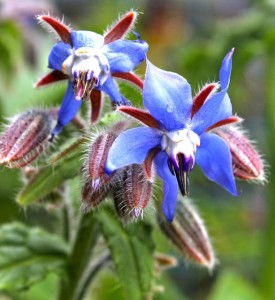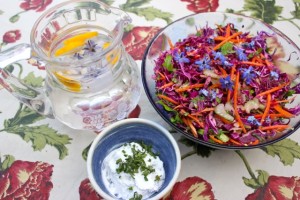Borage – Borago officinalis
Loved by bees this plant is both a weed and one we want. If you don’t have it, direct sowing of the seeds in spring and summer is best in its final position, as it doesn’t like having its long tap root disturbed. Or sow the seeds in individual pots and
transplant them as soon as large enough and hardened off. It self sows once established and growing wild has adapted to life all over New Zealand originating from central and southern Europe.
Borage is distinguished by large oval or egg-shaped rough, thick, hairy leaves with sap smelling and tasting like cucumber. The leaves are up to 30cm long by 20cm wide on the plant which stands 30-80cm tall. The stems are hairy and bristly too. The plant can topple over so may need staking. Borage likes full sun in well drained soil and is a good companion plant to bring the pollinating bees.
I love the blue flowers growing in clusters (there’s also a white variety) that droop being 20-25cm in diameter. In the centre of the flower is a cone that sticks out with dark purple/black stamens. It
flowers from Sept-May and is annual or biennial.
Borage is in the Boraginaceae family along with comfrey and forget-me-nots (which I’m delighted to recently learn that you can eat forget-me-nots leaves and flowers). Its botanical name Borago (Lat.) means hairy garment referring to the leaves; officinalis (Lat.) means medicinal.
Traditionally borage was used to relieve anxiety and stress and for lifting the spirits – you just have to look at the flowers for that! It is also used to reduce high fevers taken hot because of its diaphoretic or sweat inducing properties, making it a good remedy for colds, flu and infected lungs. The leaves and flowers are rich in potassium and calcium making it a good tonic and blood purifier.
Here’s something quirky if you burn the whole plant the nitrate of potash the plant contains will emit sparks and little explosive firework sounds. Because of its rich mineral salts it is handy for use in a salt free diet.
The Greeks and Romans believed this plant both comforted and made you courageous. So be brave
and try eating a piece of leaf, a little hairy yes, but chewing it between your two top teeth and tip of the tongue you’ll first notice the salty taste and then it will quickly dissolve tasting like cool cucumber. It’s nice chopped finely in salad, added to coconut (photo right) or dairy yoghurt, an egg and mayonnaise sandwich or include a couple of leaves in your green smoothie. Also in the photo I’ve frozen borage flowers in ice cubes along with lemon slices for a decorative addition to cool water.
Refreshing Borage Tea
3 tsp fresh borage leaves, 250ml boiling water,1 tsp honey, 1 slice lemon
Pour boiling water over the leaves, cover with a saucer and infuse 5 minutes, add the honey, slice of lemon and enjoy!
Topping off the great benefits, this plant contains GLA (gamma linoleic acid), more valuable than evening primrose oil, a good reason to include flowers and leaves in your diet. What a great all round plant to value in our gardens!







Hi Julia,
You are right, borage is a beautiful plant but you do have to get close to see how gorgeous the flowers are. What a great idea to put them in the yoghurt to get the cucumber taste. I love Indian spiced lentils and now I can still have my flavoured yoghurt to go with it, you are a genius my friend.
About your question in the last post about bitter cress, I have not found it. But I did get your point about winter cress, I am putting less in and I am pleased to report that the smoothies are getting better and better, to taste that is. I love the taste in a salad though, a bit of spark is actually quite lovely.
Before I sign off, what do you mean with ‘taken hot borage is good for flus and colds’? I feel a bit ignorant but how and what do I make hot?
Now it is spring I do hope I will not need it soon but I would like to know.
In the meantime good planting, we are putting our seedlings in and they look so cute.
Love Wilma
HI there Wilma, thanks heaps for your comments – you’re really getting to know the weeds more closely which is just great! Bittercress does give a spark in a salad doesn’t it. I want to try making my own mustard one of these days from the seeds although it might work better with wild mustard green seeds since they’re bigger.
Ok what I mean by borage taken hot for flu and colds is to make a tea of the leaves and flowers and drink it while it is still hot so that it is warming to the body and helps cause sweating to release toxins. I know I’ve felt cold when I have a cold and flu to help the sweating.
I got my seeds sown and one tomato has come up in 3 days – it just wants to grow fast I guess:).
Love Julia
Hi Julia, I love borage and we have plenty of it growing in our gardens to put in our salads and for the bees to enjoy. Your website is amazing, packed full of herbal wisdom and knowledge. Thank you Julia for sharing all this with us all. It is wonderful work you do. So looking forward to the Rotorua workshop 🙂
HI Tracey, I’m rapt that you’ve taken the time to write and give such lovely feedback – thank you so much. And I’m looking forward to meeting you in Rotorua!!
Thanks for this great information. I’ve just found borage is growing in my garden and now that I know what it is, feel comfortable putting the leaves in my morning smoothie and the flowers in my salads.